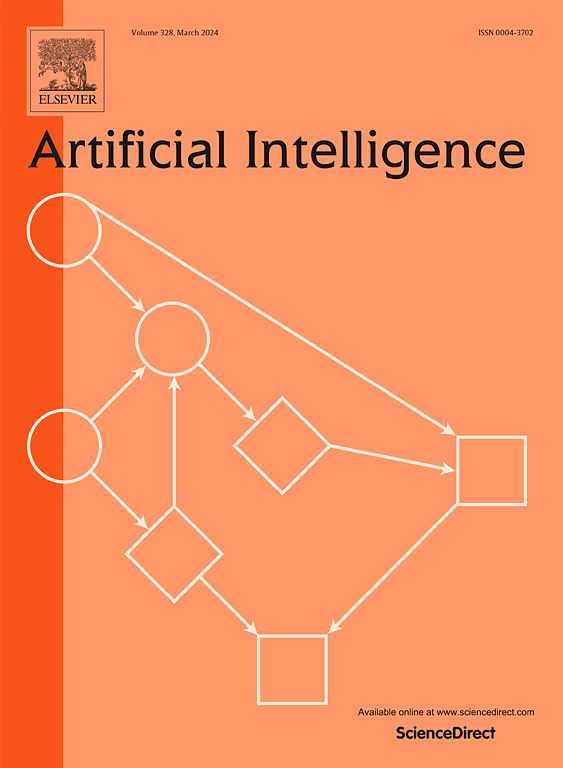最大似然证据推理
IF 4.6
2区 计算机科学
Q1 COMPUTER SCIENCE, ARTIFICIAL INTELLIGENCE
引用次数: 0
摘要
在本文中,我们旨在推广证据推理(ER)规则,建立一个新的最大似然证据推理(MAKER)框架,用于系统空间中以不完全数据为特征的从输入到输出的概率推理。MAKER框架包括三个模型:系统状态模型(SSM)、证据获取模型(EAM)和证据推理模型(ERM)。引入SSM以系统空间单态上的普通概率分布的形式描述系统输出,仅对随机性建模,或者更一般地以单态及其子集(简称状态)的基本概率分布的形式描述系统输出,以明确地描述随机性和模糊性。建立EAM是为了从数据源中获取作为系统输入的证据,证据元素在数据源的证据元素上以基本概率分布的形式存在,每个证据元素指向系统空间中的一个状态。创建ERM是为了将获得的证据片段组合在一起,每个证据都以所有状态和系统空间的功率集的基本概率分布的形式表示,以促进增强概率推理过程,其中证据的可信度与其随机性和模糊性一起明确建模。在MAKER框架中,证据的可信度是根据其可靠性和预期权重来定义的,以衡量其对所有状态的支持程度。证据对之间的相互依赖也被明确地衡量。然后建立一个通用的连接MAKER规则和算法,通过组合具有权重和可靠性并且通常相互依赖的多个证据,从多个输入推断系统输出。推导了一些特殊的MAKER规则和算法,以便在证据相互排斥或相互独立的特殊情况下进行推理。识别并证明了MAKER规则简化为ER规则、Dempster规则和Bayes规则的具体条件。建立了一种双目标非线性抢先极小极大优化模型,通过最大化每个观测值的真实状态的预测似然,利用观测数据进行证据权重和可靠性的最优学习。通过两个算例分析了MAKER框架的三个组成模型、MAKER规则和算法以及最优学习模型。提供了一个人类福祉分析的案例研究,其中使用小组调查的数据来显示MAKER框架在不同类型不确定性下的概率推理和决策的潜在应用。本文章由计算机程序翻译,如有差异,请以英文原文为准。
Maximum Likelihood Evidential Reasoning
In this paper, we aim at generalising the evidential reasoning (ER) rule to establish a new maximum likelihood evidential reasoning (MAKER) framework for probabilistic inference from inputs to outputs in a system space, with their relationships characterised by imperfect data. The MAKER framework consists of three models: system state model (SSM), evidence acquisition model (EAM) and evidential reasoning model (ERM). SSM is introduced to describe system output in the form of ordinary probability distribution on singleton states of the system space to model randomness only, or more generally basic probability distribution on singleton states and their subsets, referred to as states for short, to depict both randomness and ambiguity explicitly. EAM is established to acquire evidence from a data source as system input in the form of basic probability distribution on the evidential elements of the data source, with each evidential element pointing to a state in the system space. ERM is created to combine pieces of acquired evidence, with each represented in the form of basic probability distribution on all the states and the powerset of the system space to facilitate an augmented probabilistic inference process where the trustworthiness of evidence is explicitly modelled alongside its randomness and ambiguity.
Within the MAKER framework, the trustworthiness of evidence is defined in terms of its reliability and expected weight to measure the total degree of its support for all states. Interdependence between pairs of evidence is also measured explicitly. A general conjunctive MAKER rule and algorithm are then established to infer system output from multiple inputs by combining multiple pieces of evidence that have weights and reliabilities and are dependent on each other in general. Several special MAKER rules and algorithms are deduced to facilitate inference in special situations where evidence is exclusive or independent of each other. Specific conditions are identified and proven where the MAKER rule reduces to the ER rule, Dempster's rule and Bayes’ rule. A bi-objective nonlinear pre-emptive minimax optimisation model is built to make use of observed data for optimal learning of evidence weights and reliabilities by maximising the predicted likelihood of the true state for each observation. Two numerical examples are analysed to demonstrate the three constituent models of the MAKER framework, the MAKER rules and algorithms, and the optimal learning model. A case study for human well-being analysis is provided where data from a panel survey are used to show the potential applications of the MAKER framework for probabilistic reasoning and decision making under different types of uncertainty.
求助全文
通过发布文献求助,成功后即可免费获取论文全文。
去求助
来源期刊

Artificial Intelligence
工程技术-计算机:人工智能
CiteScore
11.20
自引率
1.40%
发文量
118
审稿时长
8 months
期刊介绍:
The Journal of Artificial Intelligence (AIJ) welcomes papers covering a broad spectrum of AI topics, including cognition, automated reasoning, computer vision, machine learning, and more. Papers should demonstrate advancements in AI and propose innovative approaches to AI problems. Additionally, the journal accepts papers describing AI applications, focusing on how new methods enhance performance rather than reiterating conventional approaches. In addition to regular papers, AIJ also accepts Research Notes, Research Field Reviews, Position Papers, Book Reviews, and summary papers on AI challenges and competitions.
 求助内容:
求助内容: 应助结果提醒方式:
应助结果提醒方式:


